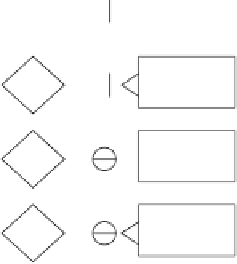Database Reference
In-Depth Information
ATTRIBUTE
(multivalued)
ATTRIBUTE
(derived)
ENTITY
ATTRIBUTE
Minimum
=
1, maximum = 1
RELATIONSHIP
(identifying)
RELATION-
SHIP
Minimum
=
1, maximum = many
KEY
SUPER
SET
Minimum
=
0, maximum = 1
ISA
Minimum
=
0, maximum = many
SUB
SET
COMPOSITE
ATTRIBUTE
Figure 7-2
E-R data model: graphical notations or symbols.
entity. Note the different notations in the figure to denote single-valued, multival-
ued, derived, and composite attributes. Also, observe the notations for the two types
of relationship. You will also note that symbols for supersets, subsets, and cardinal-
ity indicators are different from the ones used in the object-based data model
covered in Chapter 6.
ENTITIES
Consider a banking institution. For this organization, real-world things exist that are
of interest. The bank is interested in customers; it renders banking services to each
customer. The real-world thing called CUSTOMER is of interest to the bank. Cus-
tomers open bank accounts. These bank accounts may be checking, savings, or loan
accounts. As such, real-world things such as CHECKING ACCOUNT, SAVINGS
ACCOUNT, and LOAN ACCOUNT are also of interest to the organization. If you
examine the bank's operations, you will notice other real-world things that are of
interest to the bank.
In creating an E-R data model, you start by observing real-world things that are
of interest to the organization in the course of its operations. You are not really
examining individual processes; you are just listing the things, both tangible and
intangible. These real-world things are the entities that need to be included in the
data model. This is similar to recognizing business objects and including them in an
object-based data model.
While studying entities in the E-R data model, observe the similarities with the
object-based data model. Observe how entity types and entities match up with
object sets and object instances.


















Search WWH ::

Custom Search